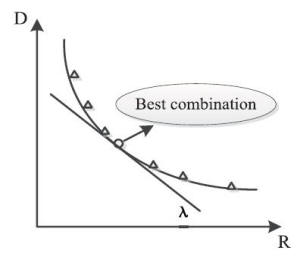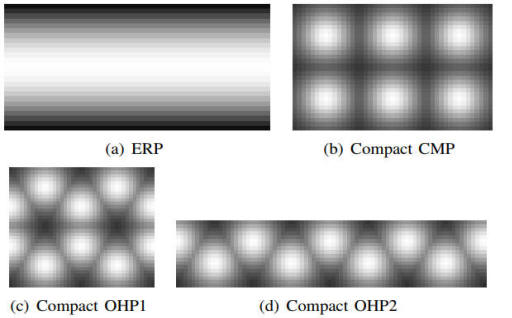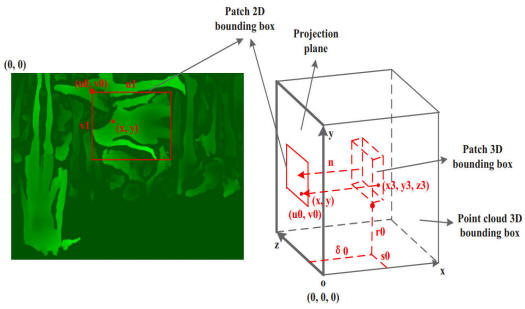Welcome To Li Li's Home Page
Home |
Research | Publication |
Links
1. Video-Based Point Cloud Compression
1)
Auxiliary-information-based motion vector prediction
 |
Contributions:
1) General 3D-to-2D motion model using the 3D
motion and 3D to 2D correspondence
2) Geometry-based motion vector prediction
3) Auxiliary-information-based motion vector prediction
4) Normaltive and non-normative solutions to utilize the derived motion
vector
|
2) Occupancy-map-based
RDO and partition
 |
Contributions:
1) Occupancy-map-based RDO
2) Occupancy-map-based partition
Occupied partition: auxiliary-information-based MVP
Unoccupied partition: padding
|
3) Unoccupied
pixel padding
 |
Contributions:
1) Unoccupied pixels that are occupied: pad
those points using the real points in the original point cloud
2) Unoccupied pixels that are unoccupied: pad the residue of the
unoccupied pixels using the average pixel of the occupied pixels
|
4) Multiview
video coding for plenoptic point cloud compression
 |
Contributions:
1) Provide a multiview-video-based framework
utilizing the high efficiency of multiview video coding standard
2) Block-based group padding to unify the unoccupied pixels across the
attribute direction
3) Occupancy-map-based rate distortion optimization
|
2. Rate Control and Bit Allocation
1)
Lambda-Domain Rate Control and Bit Allocation for HEVC
 |
Contributions:
1) Complete lambda-domain R-D analysis
framework including both R-lambda and D-lambda models
2) Optimal picture level bit allocation
3) Optimal basic unit level bit allocation |
2)
Lambda-Domain Rate Control for HEVC Scalable Extension

R-lambda
R-Q |
Contributions:
1) Initial encoding parameters determination
for both HEVC temporal, spatial, and quality scalabilites
2) Optimal picture level bit allocation
considering inter-picture and inter-layer dependencies
3) Adaptive model parameter updating scheme |
3) Rate Control for 360-Degree
Video Compression
CTU Level Weights
 |
Contributions:
1) Optimal Coding Tree Unit (CTU) level weight
for various projection formats
2) Optimal CTU level bit allocation algorithm based on the CTU level
weight
3) Optimal CTU-row level weight specified for the ERP format |
4) Rate Control for
Video-Based Point Cloud Compression
 |
Contributions:
1) The first rate control work on video-based
point cloud compression
2) Video level bit allocation between geometry and attribute videos
3) Occupancy-map-based CTU level bit allocation
4) CTU level model updating |
2. Advanced Motion Model
1)
Four-Parameter Affine Motion Model
 |
Contributions:
1) Four parameter affine motion model
2) Two affine motion prediction: advanced affine motion vector
prediction and affine model merge
3) Fast gradient-based affine motion estimation
4) Two practical affine motion compensensation tools: one-step sub-pixel
interpolation and adaptive-block-size motion compensation |
2)
360-Degree Specific 3-D Translational Motion Model
 |
Contributions:
1) Unified advanced spherical motion model to
handle the geometry distortions
2) Local 3-D padding to handle the face boundary discontinuity
3) All these methods are adapt to various projection formats including
ERP, CMP, and OHP |
3. Light Field Image Compression
1)
Lenslet-Based Light Field Image Compression
 |
Contributions:
1) 2-D hierarchical coding structure with a
limited number of reference frames
2) Distance-based reference frame selection
3) Distance-based motion vector scaling
4) Multi-pass optimal bit allocation
|
2)
Camera-Array Light Field Image Compression
 |
Contributions:
1) Quadtree-based coding structure: four
quadrants, 16 GOPs in total
2) Distance-based reference frame selection and motion vector scaling
3) One-pass optimal bit allocation according to the information of the
previous GOP
|










